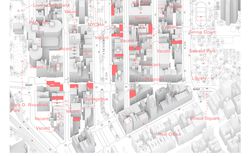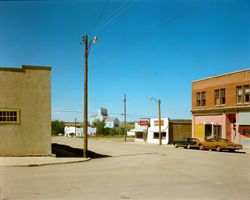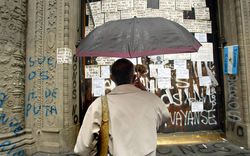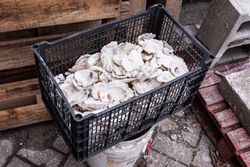archives
Niveau de description archivistique:
Fonds
Lionel March fonds
AP208
Résumé:
The Lionel March fonds, circa 1957-2017, documents the work and activities of architect and professor Lionel March. The records within this fonds illustrate March’s architectural career, representing five professional and personal building projects, including the 1964 Whitehall plan; as well as his academic career in research and teaching, spanning England and North America, most notably March’s work with the Centre for Land Use and Built Form Studies (now the Martin Centre) and his research at UCLA. The fonds is largely composed of books from March’s library, textual records, slides and photographs, and drawings.
circa 1957-2017
Lionel March fonds
Actions:
AP208
Résumé:
The Lionel March fonds, circa 1957-2017, documents the work and activities of architect and professor Lionel March. The records within this fonds illustrate March’s architectural career, representing five professional and personal building projects, including the 1964 Whitehall plan; as well as his academic career in research and teaching, spanning England and North America, most notably March’s work with the Centre for Land Use and Built Form Studies (now the Martin Centre) and his research at UCLA. The fonds is largely composed of books from March’s library, textual records, slides and photographs, and drawings.
archives
Niveau de description archivistique:
Fonds
circa 1957-2017
articles
Du fait de sa simple existence, le commerce de détail est civique et politique
Entretien de Jack Self avec Hilary Sample sur la façon dont les architectes peuvent répondre aux nouvelles dynamiques urbaines du commerce en détail
Actions:
articles
9 janvier 2023
Cette lecture critique qui s’appuie sur une série de projets représentatifs tirés de la Collection du CCA met en évidence les dynamiques quotidiennes spatiales et de pouvoir, créatrices de ces espaces médians mais rarement reconnues. Au-delà de la restitution, comment les architectes peuvent-ils participer à l’imaginaire d’avenirs plus justes pour les sites de dépossession?
Vitrines Mot(s)-clé(s):
Espaces médians, vitrines, Rafico Ruiz, Louise Paradis, autochtones, souveraineté, Ella den Elzen, Camille Saade-Traboulsi
10 février 2021 au 13 mars 2022
Espaces médians : repères de dépossession
Actions:
Description:
Cette lecture critique qui s’appuie sur une série de projets représentatifs tirés de la Collection du CCA met en évidence les dynamiques quotidiennes spatiales et de pouvoir, créatrices de ces espaces médians mais rarement reconnues. Au-delà de la restitution, comment les architectes peuvent-ils participer à l’imaginaire d’avenirs plus justes pour les sites de dépossession?
Vitrines Mot(s)-clé(s):
Espaces médians, vitrines, Rafico Ruiz, Louise Paradis, autochtones, souveraineté, Ella den Elzen, Camille Saade-Traboulsi
Projet
University Art Museum
AP143.S4.D65
Description:
File documents the unexecuted project for the University Art Museum, Long Beach, California. Material in this file was produced between 1986 and 1988. California State University, Long Beach (CSULB), commissioned Eisenman/Robertson Architects to design an art museum adjacent to the main campus entrance. The 67,500-square-foot building was to comprise four galleries, a black-box theater, an auditorium, a cafe, conference rooms, a library, offices, preparation spaces, and storage vaults. The project, sited on a 23-acre arboretum, included landscaping; terraced sculpture courtyards, botanical gardens, and a two-acre pond. Eisenman linked the northern and southern parts of the arboretum by an elevated public walkway through the museum. Sets of drawings were presented on 8 and 30 April, 2 June, and 5 Aug. In the first design phase Eisenman explores the cartographic figures which form the basis of his artificial excavation when superposed: a series of sketches establishes the analogical relationships which fix the relative scales of the plans and produce the superpositions; another series contextualizes the superposed figures by placing them within the museum site (DR1987:0859:087-090). The second phase concerns the building; the working model shows the building carved out of a square pit, from which spring an oil derrick and a reconstruction of a recreational pier (Rainbow Pier, 1920s) used here as circulatory bridge (DR1987:0859:160). In the third phase the architect systematizes his archeological procedure by using five significant cartographic dates - 1849, 1889, 1949, 1989, 2049 - each corresponding to a specific superposition (see DR1987:0859:274-277). In the fourth phase, Eisenman simplifies the superposition of 2049 to a few iconic colour-coded forms: ranch (green), ranch house (blue), campus site (red), and water forms (river and pond) (gold). Material for the fourth phase includes three relief models, four presentation drawings, and a model (property of the CSULB) (relief models: DR1987:0859:001-003; drawings: DR1987:0859:004-008). Eisenman "inhabits" his artifical archeology by detailed planning of interior spaces, and gives substance to the cartographic traces in a series of sketch sections, perspectives, and working models. Working models reveal how the central "canal" area gradually became the museum's access point (DR1987:0859:484-490); the museum, galleries, offices, and preparation areas are on one side of this deep cut, while the cafeteria and black-box theater are on the other. The upper level was to house offices, meeting rooms, and the library. File contains audiovisual material, conceptual drawings, design development drawings, presentation drawings, reference drawings, working drawings, photographic materials, and textual records.
1986-1988
University Art Museum
Actions:
AP143.S4.D65
Description:
File documents the unexecuted project for the University Art Museum, Long Beach, California. Material in this file was produced between 1986 and 1988. California State University, Long Beach (CSULB), commissioned Eisenman/Robertson Architects to design an art museum adjacent to the main campus entrance. The 67,500-square-foot building was to comprise four galleries, a black-box theater, an auditorium, a cafe, conference rooms, a library, offices, preparation spaces, and storage vaults. The project, sited on a 23-acre arboretum, included landscaping; terraced sculpture courtyards, botanical gardens, and a two-acre pond. Eisenman linked the northern and southern parts of the arboretum by an elevated public walkway through the museum. Sets of drawings were presented on 8 and 30 April, 2 June, and 5 Aug. In the first design phase Eisenman explores the cartographic figures which form the basis of his artificial excavation when superposed: a series of sketches establishes the analogical relationships which fix the relative scales of the plans and produce the superpositions; another series contextualizes the superposed figures by placing them within the museum site (DR1987:0859:087-090). The second phase concerns the building; the working model shows the building carved out of a square pit, from which spring an oil derrick and a reconstruction of a recreational pier (Rainbow Pier, 1920s) used here as circulatory bridge (DR1987:0859:160). In the third phase the architect systematizes his archeological procedure by using five significant cartographic dates - 1849, 1889, 1949, 1989, 2049 - each corresponding to a specific superposition (see DR1987:0859:274-277). In the fourth phase, Eisenman simplifies the superposition of 2049 to a few iconic colour-coded forms: ranch (green), ranch house (blue), campus site (red), and water forms (river and pond) (gold). Material for the fourth phase includes three relief models, four presentation drawings, and a model (property of the CSULB) (relief models: DR1987:0859:001-003; drawings: DR1987:0859:004-008). Eisenman "inhabits" his artifical archeology by detailed planning of interior spaces, and gives substance to the cartographic traces in a series of sketch sections, perspectives, and working models. Working models reveal how the central "canal" area gradually became the museum's access point (DR1987:0859:484-490); the museum, galleries, offices, and preparation areas are on one side of this deep cut, while the cafeteria and black-box theater are on the other. The upper level was to house offices, meeting rooms, and the library. File contains audiovisual material, conceptual drawings, design development drawings, presentation drawings, reference drawings, working drawings, photographic materials, and textual records.
File 65
1986-1988
archives
Niveau de description archivistique:
Fonds
AP196
Résumé:
Studio Gang Ford Calumet Environmental Center project records, 2003-2012, documents the design process for the Ford Calumet Environmental Center in Chicago, United-States. The records represent both phases during the competition and the full-term design, after the firm won the project. The records consist of born-digital material, sketches and drawings, textual records, photographs and seven models.
2003-2011
Documents d’archives de Studio Gang pour le projet Ford Calumet Environmental Center
Actions:
AP196
Résumé:
Studio Gang Ford Calumet Environmental Center project records, 2003-2012, documents the design process for the Ford Calumet Environmental Center in Chicago, United-States. The records represent both phases during the competition and the full-term design, after the firm won the project. The records consist of born-digital material, sketches and drawings, textual records, photographs and seven models.
archives
Niveau de description archivistique:
Fonds
2003-2011
archives
Niveau de description archivistique:
Fonds
AP119
Résumé:
The Peter Yeadon Prix de Rome project records consist of twenty ink jet printouts of computer-generated images, four sketchbooks, as well as project documentation of Yeadon's Prix de Rome project. All of the drawings were made in Rome between 1999 and 2000.
1998-2002
Documents d’archives de Peter Yeadon pour le Prix de Rome
Actions:
AP119
Résumé:
The Peter Yeadon Prix de Rome project records consist of twenty ink jet printouts of computer-generated images, four sketchbooks, as well as project documentation of Yeadon's Prix de Rome project. All of the drawings were made in Rome between 1999 and 2000.
archives
Niveau de description archivistique:
Fonds
1998-2002
articles
La place de l'argent
Juan Campanini, Josefina Sposito, Buenos Aires, CCA c/o, banques, portes, crise financière, 2001
9 janvier 2021
La place de l'argent
Juan Campanini et Josefina Sposito sur comment une esthétique de la confiance prend brusquement fin
Actions:
Projet
AP018.S1.1983.PR02
Description:
This project series documents the design and construction of the new National Gallery of Canada in Ottawa, Ontario from 1983-1988. The office identified the project number as 8303. In 1977, Parkin Architects Planners won a limited architectural competition for their design of the new National Gallery of Canada. However, after cited lack of funds, and controversies over the chosen site as well as how the competition was run, the newly formed Canada Museums Construction Company sought another design and architect for the new National Gallery. The building site was also moved from its original location near the Canadian parliament buildings on Wellington Street to the corner of Sussex Drive and St Patrick Street. Eventually, Moshe Safdie, in joint venture with Parkin Architects Planners, were chosen as the architects for the project. Parkin was the minor partner in this joint venture and his firm's work seemed to focus more on construction than design. The dispute over this decision can be found in the textual records of project series AP018.S1.1976.PR23 in this fonds. This project was commissioned by Public Works Canada and the Canada Museum Construction Company, both federal government agencies. The project is recorded through drawings, photographs and textual records dating from 1976-1989. The drawings consist largely of structural and construction drawings for the project. Some drawings in this project series were prepared by Public Works Canada. The textual records for this project include specifications, financial records, change order documentation, correspondence, interoffice letters, documentation on the competition controversy and competition reports. The textual records also focus heavily on a dispute between Parkin/Safdie and the client regarding the architects' professional fees.
1976-1989
National Gallery of Canada, Ottawa, Ontario (1983)
Actions:
AP018.S1.1983.PR02
Description:
This project series documents the design and construction of the new National Gallery of Canada in Ottawa, Ontario from 1983-1988. The office identified the project number as 8303. In 1977, Parkin Architects Planners won a limited architectural competition for their design of the new National Gallery of Canada. However, after cited lack of funds, and controversies over the chosen site as well as how the competition was run, the newly formed Canada Museums Construction Company sought another design and architect for the new National Gallery. The building site was also moved from its original location near the Canadian parliament buildings on Wellington Street to the corner of Sussex Drive and St Patrick Street. Eventually, Moshe Safdie, in joint venture with Parkin Architects Planners, were chosen as the architects for the project. Parkin was the minor partner in this joint venture and his firm's work seemed to focus more on construction than design. The dispute over this decision can be found in the textual records of project series AP018.S1.1976.PR23 in this fonds. This project was commissioned by Public Works Canada and the Canada Museum Construction Company, both federal government agencies. The project is recorded through drawings, photographs and textual records dating from 1976-1989. The drawings consist largely of structural and construction drawings for the project. Some drawings in this project series were prepared by Public Works Canada. The textual records for this project include specifications, financial records, change order documentation, correspondence, interoffice letters, documentation on the competition controversy and competition reports. The textual records also focus heavily on a dispute between Parkin/Safdie and the client regarding the architects' professional fees.
Project
1976-1989
recherche
Chercheurs en résidence 2009
Esra Akcan, University of Illinois, Chicago, États-Unis Sujet : Modernity in Translation: Geopolitical Interactions in Residential Culture Christopher Drew Armstrong, University of Pittsburgh, Pittsburgh, États-Unis Sujet : Julien-David LeRoy and the Making of Architectural History Christina Cogdell, College of Santa Fe, Gainesville, États-Unis Sujet : Emergent Genetic(...)
23 mars 2009 au 30 octobre 2009
Chercheurs en résidence 2009
Actions:
Description:
Esra Akcan, University of Illinois, Chicago, États-Unis Sujet : Modernity in Translation: Geopolitical Interactions in Residential Culture Christopher Drew Armstrong, University of Pittsburgh, Pittsburgh, États-Unis Sujet : Julien-David LeRoy and the Making of Architectural History Christina Cogdell, College of Santa Fe, Gainesville, États-Unis Sujet : Emergent Genetic(...)
recherche
23 mars 2009 au
30 octobre 2009
25 juin 2024 au 17 novembre 2024



